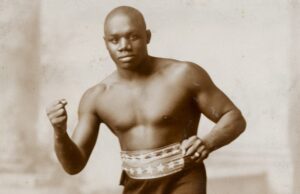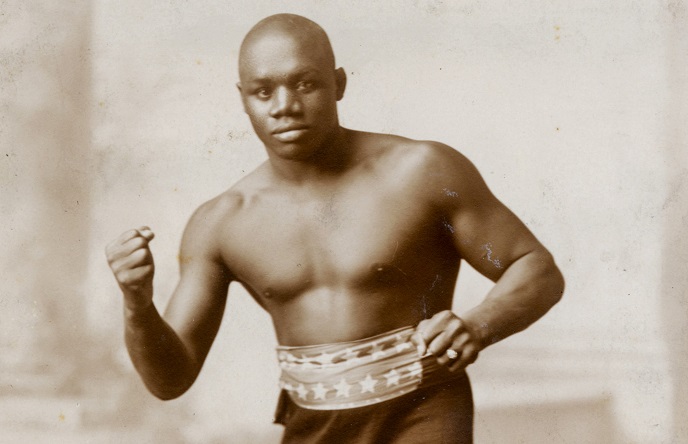In the early 1900s, the sport of boxing was in its archaic age. Lack of regulation and oversight made boxing an extremely dangerous and unglamorous job. Rampant racism also made it difficult for black fighters to earn fair shots at boxing championships or earn wages as high as their white counterparts.
It was in this unfulfilling, lawless, and cruel world of sports where Sam Langford earned his living. Largely forgotten by many boxing fans today, Langford was one of the best boxers of the era, with a career lasting 23 years in the ring. Despite being much smaller compared to his larger opponents, Sam Langford fought all he could, no matter their race, size, or reputation in the ring. Today, he is one of the greatest boxers of all time who fell victim to the current racial injustice by other fighters who refused him a shot for a championship.
Samuel Langford’s Birth and Background
Born in 1886, Samuel Edgar Langford was the son of a former slave who fled to Canada from the United States. His father was extremely abusive, so Samuel fled his home as a teenager (specific dates are uncertain as almost no records survive of his early childhood) and voyaged to Boston Massachusetts. Working as a janitor, he picked up the sport of boxing as a curiosity and began to fight in the amateur ranks.
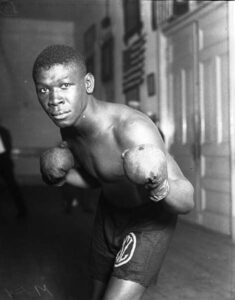
For an up-and-coming boxer like Langford, one had to find a trainer and a manager to organize fights with other local boxers, and then work your way up to face more elite competition, until you were nationally recognized.
This was a slow process, often taking years until a boxer was even mentioned in a passing newspaper report. Because boxing had yet to establish a clear standard for the sizes of the fighters facing each other, often times larger boxers would be placed against smaller and weaker opponents.
Against All Odds: Langford’s boxing abilities
In this savage arena of bloodshed, Langford’s physical disadvantages were apparent. He was about 5″7, about 155 pounds, and barely a teenager, and there are no records of who his trainers or managing team was, meaning that like most boxers in his day, he was essentially training himself and organizing his own fights. An ordinary fighter would have fallen into the cracks and would be forgotten.
But Samuel Langford was no ordinary fighter. Because of his small size, Langford was able to dart around the ring and avoid his opponents’ stronger punches. He utilized his small size to his advantage and was notorious for outmaneuvering his slower and bigger opposition. He also employed unconventional tactics in the ring, as he would hold his opponents back with one of his hands, throw a punch, and then switch hands to hold the opposing fighter. Whilst doing this, Langford would dart back and forth, twisting his body and unwinding in the direction of his punch, allowing his body to act as a rubber band.

But speed alone can’t carry a fighter far. A boxer has to implement proper defense and technique to deflect heavy blows and exploit subtle weaknesses. Anyone can punch hard or fast, but boxing skills, known as “the Sweet Science” make a hard-punching brawler a true terror in the ring, able to simultaneously outpunch and outfox his opponents.
Langford was more than capable of this, as he utilized a practical defense to protect himself. He kept his hands near his stomach, in order to protect his vital organs. When cornering his opponents, Langford would widen his stance to block off any escape routes, and then throw powerful blows as his opponent would be unable to escape.
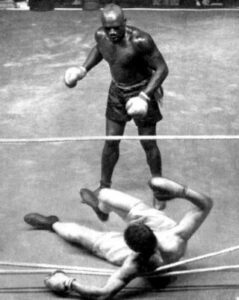
And despite his seeming physical disadvantages, Langford possessed one key weapon – long arms. His muscular arms looked mismatched compared to his small torso and legs, but since Langford had a muscular physique, his arms were extremely muscular. When Sam threw a punch, his powerful shoulders and biceps channeled extreme power into his fist, which finally deposited itself upon a truly unlucky face.
Punching power is something that you are born with, and something you can develop over time with technique. Langford had both. Because of this deadly combination of speed, skills, and power, Langford was nicknamed the Boston Bonecrusher.
“Langford took on every fighter he could [whilst] combining great punching power and agility with intelligence and courage.”
Armed with these terrifying tools, Langford began his march to the top of boxing. When discussing Langford as a fighter, it’s key to analyze the time he lived in. During the early 1900s, boxing, unfortunately, remained a racially segregated sport. White boxers would routinely ignore fighting their black counterparts, and black boxers were essentially forbidden in becoming boxing champions, of any weight class.
Because of these hurdles, Langford was destined never to attain the recognition he deserved. But in a forlorn effort to win a boxing championship, the Boston Bonecrusher did something that almost no boxers since have done: he offered to fight literally anybody who could lace on the gloves. It did not matter their age, race, or size, Langford would fight them all. This put him into an arena of giants where Langford was seemingly at a great disadvantage.
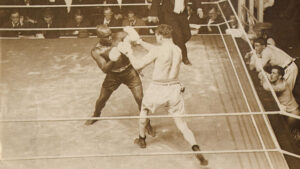
However, Langford quickly established himself as a dangerous fighter. The Boxing Hall of Fame organization would later state: “One of many top black boxers denied a chance to fight for a championship largely because of racial discrimination, Sam Langford took on every fighter he could, from lightweight to heavyweight, in his 24-year career. He combined great punching power and agility with intelligence and courage. Those who agreed to face Langford often considered him so dangerous they would request assurances that he be merciful in the ring.”
In one contest, Langford offered to touch gloves with his opponent (touching gloves is done in the final round of a boxing match) in the first round, an unusual act. When his opponent blustered “Why are you touching gloves Sam, this ain’t the final round,” Sam calmly replied, “Tis’ for you son.” Sam proceeded to knock him out in that same round.
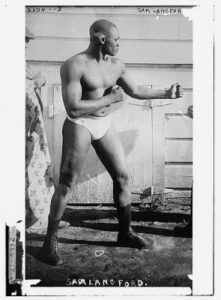
In 1903, Joe Walcott, a black boxer from Barbados, won the world welterweight title, an act that set new bounds for racial inclusiveness in the sport. Walcott offered Langford a shot at his championship, and Langford fought him in 1904. In the bout, the newspaper The Lowell Sun reported:
“Joe Walcott met his match in a 15-round bout yesterday…his opponent was Sam Langford, who clearly outpointed the champion. Langford took advantage of his longer reach and repeatedly played a tattoo on Walcott’s face, and his cleverness on his feet carried him away from Walcott. Langford met his attacks by rights and lefts to the jaw and mouth so effectively as to draw blood in the second round and he kept Walcott bleeding in every round thereafter. In the third round, Langford brought the champion to one knee by a straight away jolt to the jaw, and he went through the entire fifteen rounds without a perceptible scratch on himself.”
Despite the obvious beatdown Langford inflicted on Walcott, judges awarded Walcott the decision, which drew anger from the crowd. Langford had been robbed of his only chance at a championship.
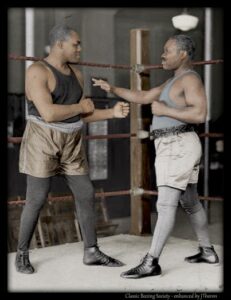
A King without a Crown
Not discouraged by this disheartening setback, Sam continued to fight whoever he could get his hands on. First, he dueled with Jack Johnson, a giant of a man who was 210 pounds and 6’0. Langford fought admirably, dealing significant damage to the much bigger man. But Johnson, who himself was an accomplished fighter, knocked down Langford in the middle of the fight and proceeded to beat down the smaller man.
“It was the first real beating I ever took,” remarked Langford. Johnson never forgot the fight the little man gave him, and when Johnson became the first black heavyweight champion of the world, he refused to give Langford a title fight, admitting “Sam Langford is the toughest little SOB who ever lived.”
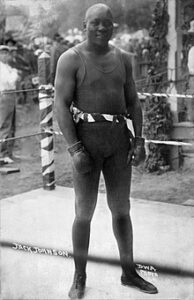
Langford then went on a 37-win streak, beating white and black fighters who consistently outweighed him. One opponent stated a fight with Langford “was like being hit with a baseball bat. He hit you so hard you didn’t feel it. I fought most of the heavyweights, including Dempsey and Johnson, but Sam could stretch a guy colder than any of them.”
“Langford fights consistently, possesses the punch, knows the game, and can whip them all right now, one after the other,” remarked John L. Sullivan, the first ever heavyweight champion, “Johnson knows this and sidesteps his fellow fighter at every turn of the road.” Langford had asserted his dominance in the sport of boxing, across nearly all weight classes. But he still lacked a title.
Langford would continue to be barred from competing for this prize by white champions because of his race and ignored by black champions because of their fear of the Boston Bonecrusher. Sam Langford was a king without a crown.
In 1908 and 1910 Langford flattened Joe Jeanette and “Fireman” Jim Flynn, and fought against Stanley Ketchel, an extremely talented former middleweight champion. Despite inflicting harsh pugilistic punishment on Ketchel for 6 rounds, the judge decided to declare the fight a draw, to avoid declaring that the black Langford had beaten a former white champion.
By 1914, Langford was 28 years old and up to this point, he had fought an astounding 137 times, with just 9 defeats! But Langford was well past his prime, as his speed and reflexes were largely gone. Years of accumulated beatings had made him weaker in the ring, and he was no longer able to resist the overwhelming size of his opponents. But he continued to fight, as throughout his life he was paid pennies for his career and thus was perpetually broke.
Langford, in an event similar to his boxing match against Jack Johnson, stepped into the ring with Harry Wills. Wills was 6″4, and weighed almost 220 pounds, outweighing Langford by 50 pounds. He was an up-and-coming heavyweight and because of his size and ferocity, was nicknamed “The Black Panther.” But Langford, through sheer force and determination, managed to beat Wills in the fight, knocking out Wills in the 19th round. “I thought I’d been killed,” stated Wills.
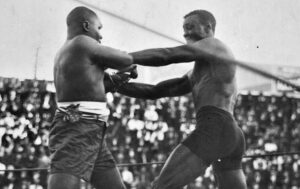
Wills would then go on to beat Langford as well in several rematches, but the ability for Langford to fight toe to toe with such a physically imposing and younger man remains an admirable accomplishment. After Jack Johnson was defeated by Jess Willard in 1915, Langford petitioned Willard for a title fight. But Willard refused to fight a black man for the title, and Langford was once again left broke.
By 1916, Langford offered to fight Jack Dempsey, an up-and-coming brawler from Manassa Colorado. But Dempsey, who would go on to win great fame as a legendary boxer, avoided the match, saying years later that “I wouldn’t fight him because I knew he would flatten me. I was afraid of Sam Langford.”

By the 1920s, Langford’s age and constant fighting had caught up to him. He was now losing more often and was blind in his left eye. Despite fortune turning against him, he journeyed to Mexico and fought for years despite his handicap. Langford would recollect that “my left eye was completely gone and the right just seeing shadows.” In one fight, Langford lost vision in his right eye and fought blind. But a lucky right-hand punch saved the day and knocked out his opponent, to the surprise of all.
This luck ran short, as by 1926 Langford was 41 years old and worn out. He was so badly battered in one fight he was unable to find his way back to his corner due to blindness and was banned from boxing to protect his health.
Alone and Forgotten
What happened next is uncertain, because Langford completely disappeared from public view. He was not mentioned in newspapers or in boxing catalogs. Despite his achievements, he became what occurred to so many other boxers in his time: an old, beaten-down man who never got much out of his cruel livelihood.
In 1944, Al Laney, a boxing fan and historian, became curious what ever became of the great Sam Langford, and when he could not find him, or what had happened to him, Laney decided to track him down. The inquisitive man finally found Langford in 1944, and saw to his horror the forgotten great, Sam Langford, was living alone, blind from his injuries, and penniless in a barren rented room in Harlem. He did not have furniture in the room or food. He sat alone in the dark and survived on scraps.
Laney managed to raise money for Langford by raising public awareness of the feats of this legendary fighter and raised enough money for Langford to live comfortably for the rest of his life. “I fought maybe three, four hundred fights,” Langford would later tell Laney, “and every one was a pleasure.” Sometime after Laney published his stories on Langford, he visited the old fighter one Christmas Eve. “I got a geetar,” said Sam, “and a bottle of gin, and money in my pocket to buy Christmas dinner. No millionaire in the world got more than that, or anyhow they can’t use more.”
Samuel Edgar Langford died from natural causes at the age of 70 in New York City, a year after he had been enshrined in the boxing hall of fame. His final professional boxing record stands at 314 fights, with 210 wins, 43 losses, and 53 draws. In a world of giants, Sam Langford was the smaller man who was hated, despised, and feared. He offers us all a lesson on determination and how to surmount challenges we are thrown in life. He was the little man that could.
